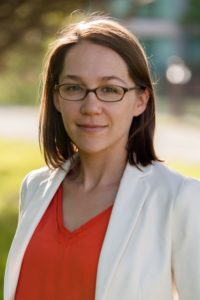Kate Ross has been captivated by the odd behaviors of electrons ever since high school. This curiosity quickly became a gateway to the wonders of quantum physics.

“I wanted to learn more about the fundamentals of what can happen in solids,” she said. In college, she discovered “the extent to which quantum physics plays a role in how electrons behave in materials is fascinating.” So, “I have found my way to studying the strange world of quantum materials,” she said.
An infamously hard problem
Now an assistant professor in the Department of Physics in Colorado State University’s College of Natural Sciences, Ross is focusing on finding long-range entanglement in quantum materials. This is no small feat – it requires all of the material’s electrons (we’re talking “one” followed by 23 zeros) to be superimposed in the same quantum state, known as quantum spin liquid.
And she has dived in. In search of an answer to what she calls “this (in)famously hard problem,” she and her lab at CSU grow crystals, freeze them down to 0.05 Kelvin, expose them to high magnetic fields (about 10 times the strength of an MRI machine), and then blast them with neutron beams.
“Experimentally there are so many possibilities that it keeps things interesting!” And contrary to what the name of her lab, Frustrated and Quantum Magnetism Research Group, might imply, the group is quite energized; “frustrated magnetism” is a scientific term describing atom positions inside crystal lattices.
Global scholar
For her work in quantum physics and electronic materials, Ross has recently been named a Canadian Institute for Advanced Research (CIFAR) Azrieli Global Scholar. As such, she joins 17 other early-career investigators from around the world and various disciplines in receiving two years of support, including $100,000, leadership training, and entry into the CIFAR Quantum Materials program, which features leading researchers.
“Being a part of the CIFAR Quantum Materials program is a huge honor,” she said. “The program consists of some of the world’s best researchers in this field, and I can interact with these ‘giants’ one-on-one.” She also hopes to “foster collaborations with the other program members.”
“This group of phenomenal young investigators is the future of research,” CIFAR president and CEO Alan Bernstein said in a statement. “The enthusiasm and energy that they bring to research is invaluable for developing new ways of thinking, new techniques in science, and innovative solutions for the challenges facing our world today.”
The program is funded by the Azrieli Foundation, which “seeks out opportunities to foster excellence in science,” President and CEO of the foundation Naomi Azrieli said in a statement. Through the program, which is welcoming its inaugural group of scholars, they hope to “have an impact on growing future research leaders.”
National prize recipient
Ross also recently received the American Physical Society 2016 George E. Valley, Jr. Prize, recognizing “one individual in the early stages of his or her career for an outstanding scientific contribution to physics that is deemed to have significant potential for a dramatic impact on the field.” The honor comes with $20,000, travel funds, and an invitation to deliver a talk at the American Physical Society’s spring meeting. The prize was awarded “for the elucidation of quantum frustrated magnetism and its expression in the ground state selection of pyrochlore magnets.”
“Being the recipient of the George Valley prize is very encouraging,” Ross said. “It means that the American Physical Society recognizes the value of what I’ve been working so hard to do – and what we’re trying to accomplish in my group at CSU. This prize has gotten me even more energized to push the quantum materials frontier forward.”